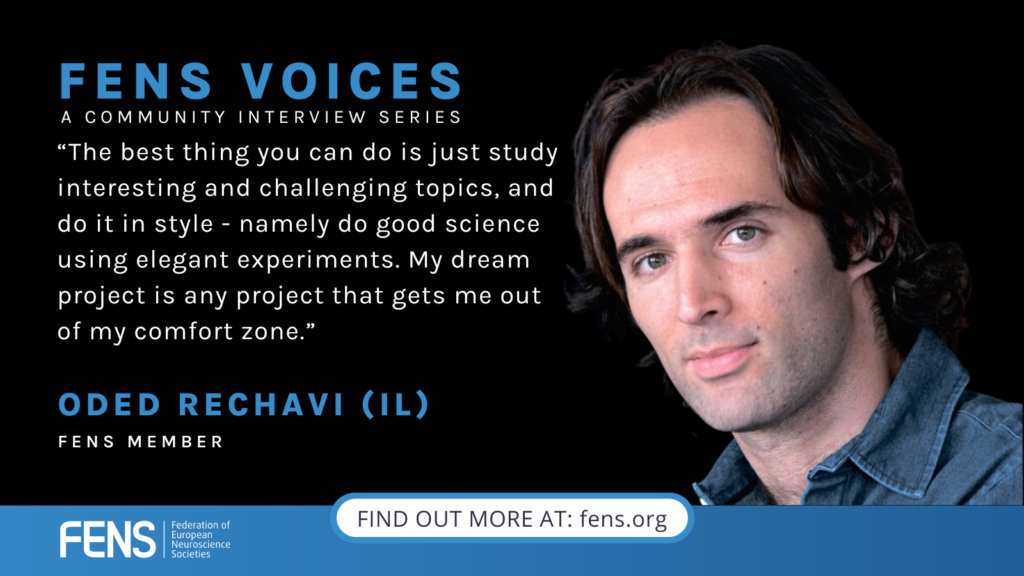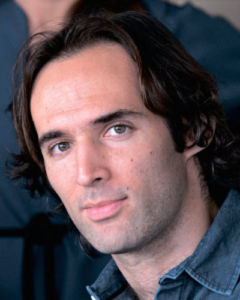
FENS Voices | Oded Rechavi: Elegant experiments and unconventional angles
18 August 2023
FENS News, Neuroscience News
FENS was excited to connect with FENS member Oded Rechavi about his mission “to challenge fundamental long-held dogmas.” Dr Rechavi is a full professor in the Faculty of Life Sciences at Tel Aviv University. He used Caenorhabditis elegans nematodes to provide direct evidence that an acquired trait can be inherited. He worked to elucidate the mechanism and rules of small RNA–mediated transgenerational inheritance, discovered that nematode brains can control the behaviour of their progeny and identified a simple neuronal circuit–level mechanism that explains economic irrationality. Dr Rechavi is a European Research Council (ERC) Fellow and has been awarded many prestigious prizes, including the Polymath Award (Schmidt Futures), the Blavatnik Award for Young Scientists, the Kadar Family Award for Outstanding Research, the Krill Prize of the Wolf Foundation for Excellence in Scientific Research, the Alon Fellowship, the F.I.R.S.T (Bikura) Fellowship and the Gruss Lipper Postdoctoral Fellowship. Read the full interview below.

When did you have your first contact with neuroscience and what made you interested in the brain?
OR: At 21 I moved to Paris with the intention of becoming an artist. I was interested in many things, including psychology and philosophy and thought about studying these topics at the university back in Tel Aviv. I sat in a coffee shop in Paris, browsing the university’s brochure, when I found out that there was a new program for neuroscience, which combines psychology, philosophy and biology – also a few other fields, such as medicine and computer science. When I started the degree I quickly discovered that neurobiology and biology (in general) attracted me the most. In particular, I was interested in memory and how it is encoded in the brain. I still think that that’s the biggest unanswered question.
How was studying Interdisciplinary neuroscience?
OR: It opened my eyes to a completely new world. I was bombarded with new concepts to think about. I understood that academia is a loophole in the world that I should take advantage of. I also met many good friends who I am still in contact with and some are my collaborators today.
The thought that stress could induce adaptive responses that would transmit to future generations was not always popular. When did you first get acquainted with the topic?
OR: That’s an understatement. It is still a very controversial idea. It has been controversial for hundreds of years. I always thought about this. Do we control our destiny? To what degree are we free or is it all pre-determined? I dove deep into the topic only during my postdoc, which I did under the mentorship of Oliver Hobert at Columbia University. When I started working on this I realised just how much the idea of inheritance of acquired traits gets on people’s nerves and I became obsessed with understanding “why” exactly. I wanted to discover what are the technical, historical, psychological and philosophical reasons this topic is so charged and annoying to so many people on the one hand and so attractive and fascinating to others at the same time.
Through your findings, you proved that small RNAs are able to mediate a type of transgenerational inheritance instead of the DNA-based inheritance, influencing evolution. Could you please tell us the story of how small RNA molecules manage inheritance?
OR: Using Caenorhabditis elegans, a very powerful model for studying inheritance, we studied how nematodes transfer acquired information transgenerationally in the form of small RNA molecules. We found that heritable small RNAs are transcribed in response to different environmental challenges and transmit inherited gene regulation in ways that can be detrimental or beneficial for the next generations. Inherited small RNAs transfer to the nucleus where they control transcription and change the chromatin environment. Chromatin modifications in turn feedback to promote or restrict additional rounds of small RNA generation and inheritance. In the cytoplasm, small RNAs are amplified by RNA-dependent RNA polymerases (RdRPs). That’s really the secret for their perpetuation over time and generations. The progeny’s pool of heritable small RNAs is sorted and shaped by liquid-like germ granules and small RNAs also destroy their mRNA targets in the cytoplasm. Production of small RNAs in the parents generates unique transgenerational silencing responses that do not obey Mendel’s rules and last multiple generations. Heritable endogenous small interfering RNAs control the transcription of many genes across the genome in ways that are only partially understood and dedicated factors are required specifically just for small RNA inheritance. We discovered genes that function specifically to promote or restrict small RNA inheritance and for determining how long each response would last. We discovered that stress can “re-set” heritable small RNA programs and identified simple rules that explain how small RNAs are segregated across lineages and create diversity amongst genetically identical individuals. We now know that small RNA inheritance is an evolved, dedicated and tightly regulated mechanism. We also discovered that small RNAs which are produced in neurons control gene expression transgenerationally, breaking down the “Weismann Barrier” (the barrier that is thought to segregate the germline from the soma) and that heritable information can bias the progeny’s decision in ways that might affect their evolution. For example, we recently showed that when worms are grown in high temperatures it disrupts normal small RNA inheritance, compromising sperm production for many generations, which forces the worms to mate more and thus to diversify their genome.

Given that these results can help us understand how complex traits and diseases are inherited, what are your hopes regarding treatments for diseases with unidentified causative genes?
OR: We still don’t know if the type of mechanisms that C. elegans studies revealed is conserved in humans. That’s the billion-dollar question. If indeed it happens, and this is something that remains to be seen, then it’s a whole new layer of information that we have been ignoring. The first stage would be to use this information for diagnosis.
Recently, your lab was involved in a different project, as your team pieced segments from the Dead Sea Scrolls by sequencing ancient DNA extracted from the animal skins on which the scrolls were written. Are you also passionate about history and helping to decipher ancient texts?
OR: I am interested in history and using DNA sequencing to piece together the puzzle of the Dead Sea Scrolls was one of the most enjoyable projects I ever took part in. I hope to do more of that in the future and, indeed, I have a few other projects in the lab where we try to use insights from biology to better understand ancient history. These include other techniques, not just DNA sequencing. I think that’s the beauty of interdisciplinary science: you discover new things if you adress the problem from unconventional angles.
Do you plan to continue your research related to inheritance and evolution? What would your dream project be?
OR: I am already working on my dream projects, in the plural, because the dream project is just any exciting idea that sparks your curiosity. You never know what will be important twenty years from now. The best thing you can do is just study interesting and challenging topics, and do it in style – namely do good science using elegant experiments. My dream project is any project that gets me out of my comfort zone. Another aspect that is very important is interdisciplinarity – that’s a recipe for interesting science. I study a very wide range of questions, from epigenetic mechanisms and small RNAs to decision-making, rationality, archelogy, hardcore neuroscience and more. On most of these projects, I am collaborating with scientists from other fields.
Which scientist did you admire while aspiring to become a researcher?
OR: I started thinking about becoming a scientist quite late, in my 20s. My science superhero is my father, Gideon (Gidi). Not only is he an amazing and highly accomplished scientist, but he’s also an MD-PhD and does research in parallel to practicing medicine. He made incredible seminal discoveries, but more importantly, he also takes himself very lightly and does it all for fun and out of curiosity.
People are continuously searching for role models, across disciplines. You surely inspired many scientists. How did it feel to be under the spotlight from the beginning of your career?
OR: If I am somebody’s role model then it makes me very happy and I hope I’m doing a good job at it. I had the pleasure of receiving supportive emails from scientists that I don’t know, saying how much they enjoyed reading our papers or listening to a talk, or how they got inspired by something we did in the lab. Nothing makes me happier, it’s the best part of the job. I try to be a good mentor to anyone who wants my advice, especially to my lab members. I’m still young and am still learning myself.
About the Federation of European Neuroscience Societies (FENS)
Founded in 1998, the Federation of European Neuroscience Societies is the main organisation for neuroscience in Europe. It currently represents 44 national and single-discipline neuroscience societies across 33 European countries and more than 22,000 member scientists. Discover FENS and subscribe to our biweekly News Alert, with information on our latest calls and activities. Find out how to become a FENS member and join the neuroscience community!